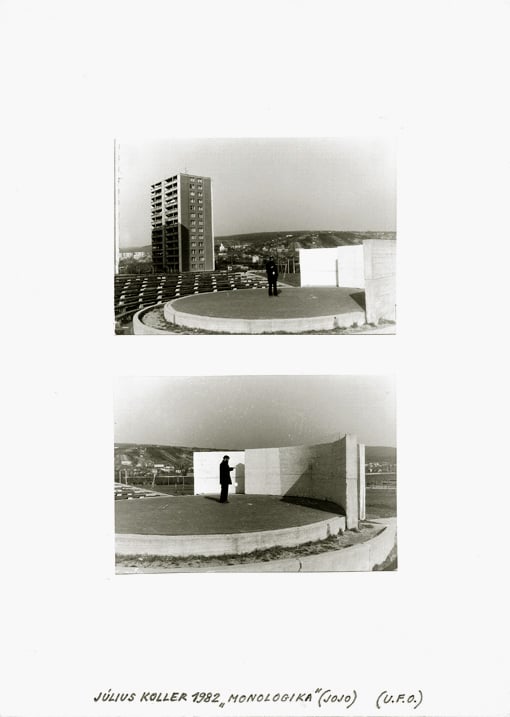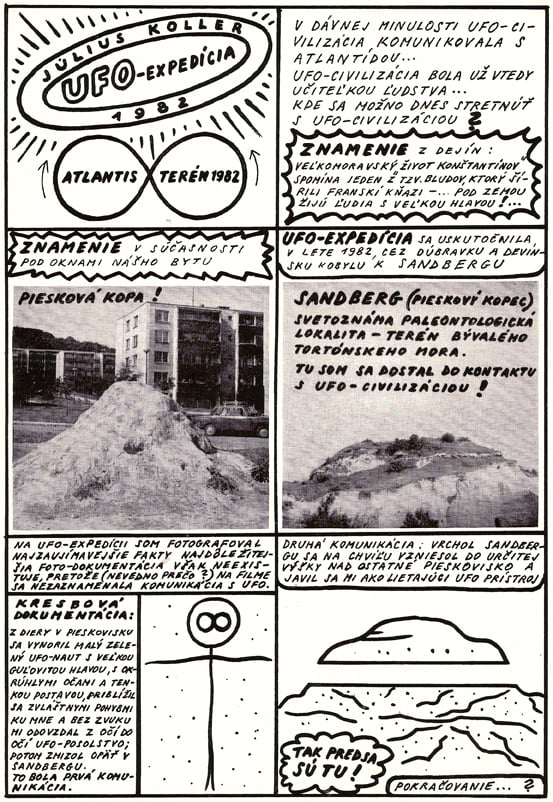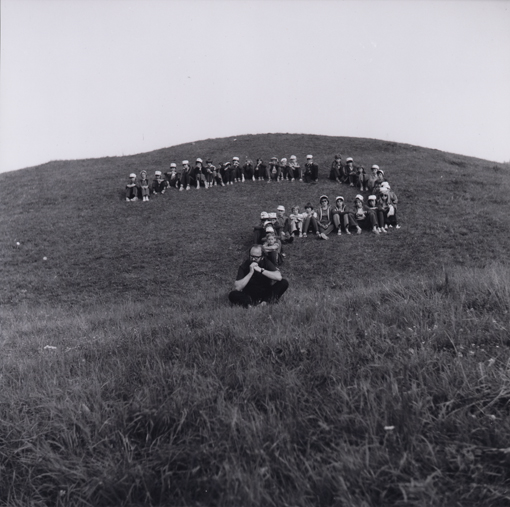
© » KADIST
Jorge Julián Aristizábal
Drawing & Print (Drawing & Print)
La Masacre de el Aro (The Massacre of El Aro) by Jorge Julián Aristizábal refers to a massacre in Colombia which occurred on October 22, 1997 in the municipality of Ituango, Department of Antioquia. On this day, 15 individuals accused of being leftist supporters of FARC were massacred by paramilitary groups. Perpetrators also raped women, burned down 43 houses, stole cattle and forcibly displaced 900 people.

© » KADIST
Julian Abraham
In 2015, while in residence at the Jatiwangi Art Factory (JaF) located in the village of Jatisura in Jatiwangi, West Java, Indonesia, Togar initiated the Jatiwangi Cup in which the artist, together with communities in the area, established an annual bodybuilding contest. The area is renowned for its roof tile factories, and the cup aims to celebrate the factory worker’s physiques, sculpted by intense, daily, physical labor. Togar based the idea of the cup on the simple notion of collectivity.

© » KADIST
Juliana Huxtable
Herculine’s Prophecy by Juliana Huxtable features a kneeling demon-figure on what appears to be a screen-print, placed on a wooden table, which has then been photographed and digitally altered to appear like a book cover, with a title and subtitle across the top, and a poem written across the bottom. This composition is stuck to a metal plate by a series of button magnets, with interjecting phrases on them. The juxtaposition between the mysogynistic, almost puritan poetry that stripes across the bottom and the powerful crouching pose that the femme demon assumes inverts the hegemonic text , instead creating a space of alterity.

© » KADIST
Julius Koller
The photograph Monologic – Yo-Yo 1, 2 (U. F. O. ), (1982), shows Koller playing with a big white Yo-Yo in a drab concrete building among a group of tower blocks.

© » KADIST
Julius Koller
Drawing & Print (Drawing & Print)
Anti-Happening refers to Koller’s 1965 manifesto, ‘Anti-Happening (System of Subjective Objectivity)’. In opposition to the notion of a ‘happening’ as a way of actualising group identity, in his manifesto, Koller stated that his concept of the ‘anti-happening’ aimed at a ‘cultural reshaping of the subject, at awareness, at the surroundings and the real world’ [i] . Unlike happenings, these actions do not involve the staging of psychologically expressive performances.

© » KADIST
Jorge Satorre
In 1872, a German scientist, Sir Julius von Haast, found the fossilized remains of a giant bird in New Zealand, that was soon connected to the Maori legend of the Hokioi. The Maori folklore recounts the story of an eagle of immense proportions that was said to be capable of devouring human beings. The bones uncovered by the scientist included a femur, one rib, and two claws.

© » KADIST
Jorge González
Easy to fold and carry, Jorge González’s Banquetas Chéveres (Chéveres Stools) embody the nomadic and flexible nature of the Escuela de Oficios. González’s work employs a modernist language while paying homage to artisanal techniques specific to Puerto Rico and the Indigenous knowledge, people, and histories of the Carribean. Reinterpreting the furniture line ArKlu (1945-1948) conceived by the architects Stephen Arneson and Henry Klumb, the stools were conceived in collaboration with various artisans in Puerto Rico–Eustaquio Alers, a weaver from Aguadilla, Joe Hernández from Ciales, and MAOF from San Juan, a contemporary wood-salvaging collective, among others.

© » KADIST
Julian Abraham
In 2015, while in residence at the Jatiwangi Art Factory (JaF) located in the village of Jatisura in Jatiwangi, West Java, Indonesia, Togar initiated the Jatiwangi Cup in which the artist, together with communities in the area, established an annual bodybuilding contest. The area is renowned for its roof tile factories, and the cup aims to celebrate the factory worker’s physiques, sculpted by intense, daily, physical labor. Togar based the idea of the cup on the simple notion of collectivity.

© » KADIST
Julian Hoeber
Every work in Hoeber’s 2011 series Execution Changes is titled in alphanumeric code. The geometric pattern that composes each acrylic-on-panel painting is determined by a preordained ratio of 2 to 3. But even though a formulaic system determines the image’s structure, its surface is full of painterly effects.

© » KADIST
Jorge de León
Jorge de León most well-known work was a radical gesture, and one of his earliest artworks: in his 2000 performance, The Circle, de León sewed his own mouth closed as a protest against the silencing of citizens in the face of social corruption. His Cristal series is more demure, but follows a similar theme. In these works, delicate, web-like lines emerge against dark backgrounds, creating orbs of negative space, pitch black.

© » KADIST
Juan Capistran
White Minority , is typical of Capistran’s sampling of high art genres and living subcultures in which the artist subsumes an object’s high art pedigree within a vernacular art form. Here, Capistran humorously remixes the form and style of Frank Stella’s Black Paintings with California punk rock band Black Flag’s song title and logo (created by artist Raymond Pettibon). White Minority , then, appropriates, recontextualizes, and riffs on language and visual signs to unmoor notions of identity, power, and revolution.

© » KADIST
Juan Araujo
Residencia Milan 1 is a painting of a house surrounded by lush forest. The image depicted is both photorealistic and creates the illusion of an unfolded piece of paper, with creases and discolorations. In referring to the circulation of images, the painting raises questions of a viewer’s relationship to the image of a beautiful house: as icon, wish, or standard of beauty.

© » KADIST
Juan Capistran
The 10 $1 bills that make up From a Whisper to a Scream (2012) read like instructions in origami. From left to right, each bill is progressively folded up, step by step, into the shape of a gun. Both a scream and a whisper are capable of conveying the same content, if at drastically different decibels, the artist proposes.

© » KADIST
Juan Brenner
The photographic series Tonatiuh (The Son of the Sun) by Juan Brenner is an in-depth visual study of current Guatemalan society from the perspective of miscegenation and the incalculable consequences of the Spanish conquest. Establishing Spanish conquistador Pedro de Alvarado as a central figure, not only in the conquest of Guatemala, but also in the formation of a complex, segregated society, Brenner proposes a series of images that re-establish the lens through which to consider both a historical and contemporary Guatemala. Tonatiuh is a visual essay on the state of a country on the verge of failure and its incapacity to address its own history and learn from it.

© » KADIST
Julien Crépieux
Julien Crépieux is interested in the medium of video and its confrontation with cinema. Microfilm is a video transcription of a cinematographic work. It isn’t a remake or an adaptation, but a transcription in the musical sense.

© » KADIST
Juliana Góngora
Lengüitas sagradas (Blessed Little Tongues) by Juliana Góngora is the result of a careful creative job between Juliana Góngora and the Koreguaje community and their workshop Masipai. During several months, the artist and the community leaders Juven Piranga and Yinela Piranga kept an essential communication to materialize one hundred miniature bags, knitted with cumare and containing tiger chocho and rattle seeds inside. Each ‘little tongue’ has been knitted using the colors that identify the clans that form the artisans of the Masipai group (wise people).

© » KADIST
Julien Creuzet
Full title of the work: Grain par Grain, sur le parterre humide et fissuré. Érosion sévère, graine, ma cote. Où est la manne, semence de l’antiquité.

© » KADIST
Julio Cesar Morales
Drawing & Print (Drawing & Print)
Julio Cesar Morales’s watercolor drawings, Undocumented Intervention , show a variety of surprising hiding places assumed by people trying to cross into the United States without documentation. Morales drew inspiration from both his childhood near the United States-Mexico border as well as from photographic documentation on U. S. government websites.

© » KADIST
Julia Rommel
On the artwork, Rommel states: “I was reading Jonathan Franzen’s new novel Purity, where they take a lot of walks through the jungle in Uruguay, or Paraguay, I can’t remember. One of the characters takes a walk and jumps off a cliff; it’s kind of dark. The painting reminded me of a long, dark, and very serious walks in beautiful places.” With references to Howard Hodgkin in the incorporation of the stretcher into the painting and certain kinds of mark making, to Matisse’s cut outs and to the history of Cubist collage, Rommel has created a dreamy oeuvre that manifests her strong conceptual interest in process and unmapped journeys.

© » KADIST
Julius Koller
Wordplay was a central focus of Koller’s work, in particular the acronym U. F. O, which he adapted in his diagrammatic drawings to stand variously for Univerzálna Futurologická Organizácia (Universal Futurological Organization, 1972–3), Univerzálny Filozoficky Ornament (Universal Philosophical Ornament, 1978) or Underground Fantastic Organization (1975), and which also appeared in a series of slapsticky self-portraits titled ‘U. F. O.–naut’ (1970–2007). These infinite variations on a common cipher constituted an insistent incantation of the Utopian principle.

© » KADIST
Julius Koller
Drawing & Print (Drawing & Print)
Wordplay was a central focus of Koller’s work, in particular the acronym U. F. O., which he adapted in his diagrammatic drawings to stand variously for Univerzálna Futurologická Organizácia (Universal Futurological Organization, 1972–3), Univerzálny Filozoficky Ornament (Universal Philosophical Ornament, 1978) or Underground Fantastic Organization (1975), and which also appeared in a series of slapsticky self-portraits titled ‘U. F. O.–naut’ (1970–2007). These infinite variations on a common cipher constituted an insistent incantation of the Utopian principle.

© » KADIST
Julius Koller
This work is one of Koller’s many variations which he began to use from 1970 to describe the ‘cultural situations’ he created. His “Anti-Happenings” turned mundane events into ‘cultural’ and ‘subjective’ situations. He sought to create new cultural situations that weren’t new art, but rather new ways of living: a new creativity for a new humanistic culture.

© » KADIST
Juan Araujo
Drawing & Print (Drawing & Print)
Many of Araujo’s works depict reproductions and Libro Ponti II is a recreation of a book on Italian architect Gio Ponti. Ponti designed the Villa Planchart a private, modernist house in Caracas, Venezuela, which at the time it was built in 1956, reflected the emergence of a class increasingly globalized, both culturally and economically. Araujo’s replica of the book thus refers to the role and visibility of Venezuela in circuits of global cultural production.

© » KADIST
Juan Obando
They/Them by Juan Obando is a video essay and deepfake that uses Adobe Stock clips, maintaining their branded watermark, but animating the scenes underneath with a narrative of self-critical awareness. It’s a meta-narrative that uses the staged scenarios (as evidence) to talk about the variable politics (and mercenary capitalism) of the stock footage industry and the misinformation dilemma we’re facing with the arrival of AI technology. In a surprising reversal, a deepfake is used to tell the truth.

© » KADIST
Juan Capistran
The Breaks reflects Capistran’s interests in sampling and fusing different cultural, social, and historical sources. Growing up in an African-American community in Los Angeles, Capistran has long been influenced by hip-hop culture. The photographs in this print document him surreptitiously breakdancing on Carl Andre’s iconic lead floor piece after the guards at the Los Angeles County Museum of Art have left the gallery.
Julius Koller
- location: Pieštany, Slovenská Republika
- year born: 1939
- gender: male
- nationality: Slovakian
Julio Cesar Morales
- location: San Francisco, California
- year born: 1966
- gender: male
- nationality: Mexican
- home town: Tijuana, Mexico
Juan Araujo
- year born: 1971
- gender: male
- nationality: Spanish
- home town: Caracas, Venezuela
Juan Capistran
- location: Los Angeles, California
- gender: male
- nationality: Mexican American
- home town: Guadalajara, Mexico
Julian Abraham
Julian Abraham “Togar” is an artist, musician, and pseudo-scientist...
Julien Creuzet
The work of Julien Creuzet reveals painful stories – both personal and political – making it impossible separate one from the other...
Juliana Huxtable
- location: New York, New York
- year born: 1987
- nationality: American
Jorge Satorre
Jorge Satorre’s practice prioritizes manual processes and experiments with different materials in specific historical or geographical contexts...
Juan Obando
As a Colombian who studied and now lives in Arizona, Juan Obando has a non-native perspective on the media-obsessed culture of the US...
Julian Hoeber
- location: Los Angeles, California
- year born: 1974
- gender: male
- nationality: American
- home town: Philadelphia, Pennsylvania
Juan Brenner
Born and raised in Guatemala, photographer Juan Brenner spent ten years in New York City working in the fashion industry before returning to his home country in 2008...
Julia Rommel
Julia Rommel (b...
Juan Covelli
Juan Covelli uses technology as a medium;, striving to decolonize the museum through digital practices, he releases archives from institutional control for the sake of emancipation...
-
-
1970-1979
Julius Koller
1978This work is one of Koller’s many variations which he began to use from 1970 to describe the ‘cultural situations’ he created...
-
1980-1989
Julius Koller
Drawing & Print
1982(Drawing & Print) Wordplay was a central focus of Koller’s work, in particular the acronym U...
-
2000-2009
Juan Capistran
2002The Breaks reflects Capistran’s interests in sampling and fusing different cultural, social, and historical sources...
Juan Capistran
2005White Minority , is typical of Capistran’s sampling of high art genres and living subcultures in which the artist subsumes an object’s high art pedigree within a vernacular art form...
Julio Cesar Morales
Drawing & Print
2006(Drawing & Print) Julio Cesar Morales’s watercolor drawings, Undocumented Intervention , show a variety of surprising hiding places assumed by people trying to cross into the United States without documentation...
Juan Araujo
Drawing & Print
2006(Drawing & Print) Many of Araujo’s works depict reproductions and Libro Ponti II is a recreation of a book on Italian architect Gio Ponti...
Julio Cesar Morales
2008The video Interrupted Passage presents a performance Morales staged in the former home of Mariano Guadalupe Vallejo, a mid-nineteenth-century Mexican general serving in California...
-
2010-2019
Julian Hoeber
2011Every work in Hoeber’s 2011 series Execution Changes is titled in alphanumeric code...
Julio Cesar Morales
2011Contrabando is a work that references the larger sociological phenomenon in which immigrant economic strategies come to infiltrate urban landscapes...
Juan Capistran
2012The 10 $1 bills that make up From a Whisper to a Scream (2012) read like instructions in origami...
Julien Crépieux
2012Julien Crépieux is interested in the medium of video and its confrontation with cinema...
Juan Carlos Alom
2012In Amantes (Lovers) Juan Carlos points his lens at his own environment, his underground (literally) studio in Havana...
Jorge de León
2015Jorge de León most well-known work was a radical gesture, and one of his earliest artworks: in his 2000 performance, The Circle, de León sewed his own mouth closed as a protest against the silencing of citizens in the face of social corruption...
Julia Rommel
2015On the artwork, Rommel states: “I was reading Jonathan Franzen’s new novel Purity, where they take a lot of walks through the jungle in Uruguay, or Paraguay, I can’t remember...
Jorge Julián Aristizábal
Drawing & Print
2017(Drawing & Print) La Masacre de el Aro (The Massacre of El Aro) by Jorge Julián Aristizábal refers to a massacre in Colombia which occurred on October 22, 1997 in the municipality of Ituango, Department of Antioquia...
Juliana Huxtable
2017Herculine’s Prophecy by Juliana Huxtable features a kneeling demon-figure on what appears to be a screen-print, placed on a wooden table, which has then been photographed and digitally altered to appear like a book cover, with a title and subtitle across the top, and a poem written across the bottom...
Jorge González
2017Easy to fold and carry, Jorge González’s Banquetas Chéveres (Chéveres Stools) embody the nomadic and flexible nature of the Escuela de Oficios...
Juan Brenner
2018The photographic series Tonatiuh (The Son of the Sun) by Juan Brenner is an in-depth visual study of current Guatemalan society from the perspective of miscegenation and the incalculable consequences of the Spanish conquest...
Julian Abraham
2019In 2015, while in residence at the Jatiwangi Art Factory (JaF) located in the village of Jatisura in Jatiwangi, West Java, Indonesia, Togar initiated the Jatiwangi Cup in which the artist, together with communities in the area, established an annual bodybuilding contest...
Jorge Satorre
2019In 1872, a German scientist, Sir Julius von Haast, found the fossilized remains of a giant bird in New Zealand, that was soon connected to the Maori legend of the Hokioi...
Julian Abraham
2019In 2015, while in residence at the Jatiwangi Art Factory (JaF) located in the village of Jatisura in Jatiwangi, West Java, Indonesia, Togar initiated the Jatiwangi Cup in which the artist, together with communities in the area, established an annual bodybuilding contest...
-
2020-2029
Juliana Góngora
2020Lengüitas sagradas (Blessed Little Tongues) by Juliana Góngora is the result of a careful creative job between Juliana Góngora and the Koreguaje community and their workshop Masipai...
Juan Covelli
2021El Salto (The Jump/The Waterfall) by Juan Covelli depicts the Salto de Tequendama, a waterfall located on the outskirts of southwest Bogota...
Juan Obando
2023They/Them by Juan Obando is a video essay and deepfake that uses Adobe Stock clips, maintaining their branded watermark, but animating the scenes underneath with a narrative of self-critical awareness...









